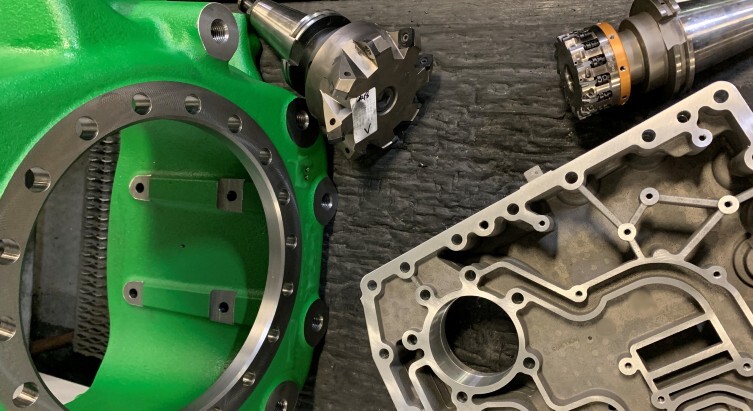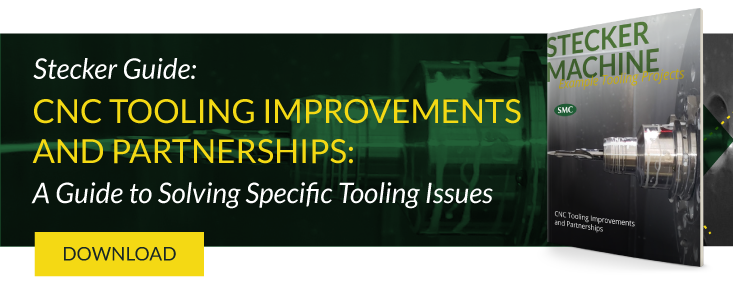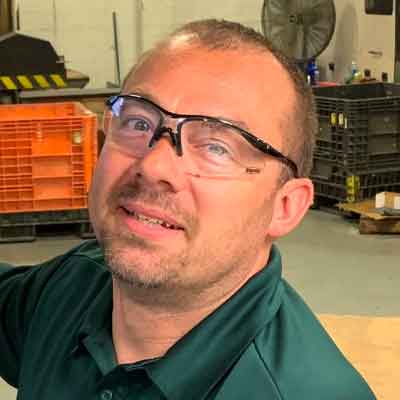Design Parts to Use Larger Cutting Tools Dfm Quizlet
8 Important Considerations When Selecting CNC Machine Cutting Tools

What do you need out of a CNC machining metal cutting tool? That's simple, right? How you want a tool to perform is cut and dried. What's challenging for many engineers in CNC machine shops is how to select the right tool to make sure the job gets done properly. Of course, selecting a CNC machine cutting tool isn't only about the performance of the tool. Cost is a huge factor, and we'll address that in this article, too. Here is what engineers should be considering when selecting a CNC machine cutting tool. Tool selection depends a lot on workpiece material. Stecker Machine primarily machines aluminum, ductile iron, and grey iron castings. We have favorite CNC machining metal cutting tools for each material. Engineers choose to use the proven standardized tooling first, which helps reduce risk, inventory, and costs. Tooling such as drills, mills, and taps are required to machine different features, and there's standard tooling for each tool type and material. For example, Stecker has three different standard 90° square shoulder face mills, one each for machining aluminum, ductile iron, and grey iron. Of these materials, aluminum has the highest machinability, so the aluminum tooling has higher surface feet per minute (SFM) specifications, so they can run faster. In general, specialty, high-end cutting tools are selected for high-volume projects, and low-volume jobs use more economy-level tooling. It comes down to economy of scale, with the cost of high-end, feature-specific tooling being justified by the high quantity of parts to be made by that tool. Multiple-feature tools can be huge cost- and labor-savers in CNC machining. If multiple tasks — three or four or more — can be completed by one tool, it cranks up cycle time while also reducing the time needed to change out the tooling. For instance, when designed properly, an insertable combo tool can drill and chamfer possibly three different ways, getting the job done in one pass with one tool, instead of six tools (and six passes). Yes, that custom-made, multiple-feature tool may cost upwards of $3,000, but the savings add up quickly to offset the costs, especially on a high-volume project. Most cutting tools can be used in most CNC machines. That doesn't always mean those machines are the most efficient, however. Engineers and operators know that a greater horsepower machine (with a bigger taper) provides opportunities to use combo tools that can perform many functions. Whereas large castings require the help of hoists to move them, smaller castings don't have that challenge. In fact, there may be opportunities for increased efficiency by designing a fixture that can run two or three small parts at the same time on a larger machine. That's an example of when large machine = large casting doesn't necessarily hold true. Finding the best efficiency is mostly about selecting the right tool to match the project needs and the machine's ability and availability to run it. If a machine can run multiple parts at the same time and the operator changes out three instead of one, that's a no brainer. Running multiple parts on a pallet saves time by reducing the number of pallet and tool changes per part. For example, running three parts simultaneously, compared to one, saves 1/3 the tool change and pallet change time per part, plus it increases rapid motions between the three parts in the machine center. The same cutting tool can be made from many different materials, some more durable (and expensive) than others. Solid carbide is a material that creates a reliable cutting tool. Yet, a PCD-tipped tool reaches another durability level. PCD, or polycrystalline diamond, is made by sintering diamond particles with a metallic binder to create the hardest modern cutting tool. While tool life for a PCD-tipped drilling tool is approximately 4X that of a solid carbide tool (2,500 pieces versus 10,000), it can also run 25% faster. That difference in production (faster spindle speed, extra feed rate, AND savings in labor, setup, etc.) offsets the cost difference between the two (around $180 for carbide versus $960 for PCD). In addition to its initial durability, a PCD tool can be retooled over and over, while a toolmaker can only regrind a solid carbide tool so many times before losing diameter by getting too far down in the back taper to drill. Even if grinding .005 to .010 inches each time, eventually that carbide tool will wear down too far. Many CNC machine shops use cutting monitors and/or tool life counts to predict when a tool may fail. Those, combined with experienced operators inspecting tools to see wear on the cutting edges, help ensure that each piece is cut properly. A less expensive option to solid carbide is using a steel tool body with brazed carbide inserts or pockets, which can drop costs by 75%. Other options are high-speed steel tools and carbide-tipped tools, which further drops cost and performance, and are usually used by smaller CNC machine shops. Just like any vendor partnerships, a toolmaker and CNC machine shop work best when they're familiar with each other. And again, like any relationship, familiarity can only be built when a shop invests in a strategic number of vendor partnerships. Typically, a large CNC machine shop invests in partnerships with upwards of seven to eight toolmakers, each usually having a niche that fulfills specific challenges: solid carbide tooling, insertable combo tools, PCD-tipped tools, step combo tools for spool bores, etc. Once trusting relationships have developed, CNC machine shops may benefit from increased buying power, occasional expedited projects, or just an overall willingness to go the extra mile to satisfy a customer during a challenging job. Again, the larger, more experienced CNC shops have the advantage here. Engineers in large CNC machine shops may concept and design over ¾ of all tooling needed within that shop. For instance, if the project requires an insertable combo tool, the engineer sends the part print and model to the toolmaker rep and, together, they complete the design. That hands-on connection results in a more reliable overall project. Small CNC machine shops must completely rely on their toolmaker rep for design and engineering expertise. When engineers determine how a new project will be completed in the shop, they often create a best-case scenario (best tooling, aggressive cycle times, high-end fixturing), and then also have a "Plan B" (less expensive tooling, less powerful machines, etc.). The temptation is to stay competitive by choosing a less expensive option, which usually means the tooling suffers. The fault in that logic is not accounting for possible tooling challenges that not only end up costing as much as the original best-case scenario, but the cost of wasted time is also added to the project. That's why high-end, experienced, confident CNC machine shops don't seriously consider "Plan B" options. Leadership understands the value of immediately selecting high-quality materials and using the best processes to complete a job, staying ahead while the competition chases. Some CNC machine shops have more experienced staff than others. Nothing can replace the insight gained from decades of successful projects using CNC machines. These frontrunners are familiar with handling projects from design to assembly, and they have the right processes in place as well as a lot of the right tools ready to go. So, how does an up-and-comer join an experienced CNC machine shop? After all, selecting tools is not a skill taught in even the best higher education CNC classes or training sessions. In this case, it's an example of tribal knowledge: expertise passed down from engineer to engineer, usually within high-end CNC machine shops. How can you evaluate a shop's capabilities when it comes to selecting CNC milling machine cutting tools without seeing them work on your project? It's a difficult task. Look for experience first and ask for references. You can also review these three signs that a CNC machine shop knows how to choose the right tools for complex parts. Now you know not only how you want a CNC tool to perform, but you also know what engineers should look for when selecting CNC machining cutting tools. Now, learn how to maximize your CNC tooling practices by reading this: CNC Tooling Improvements and Partnerships: A Guide to Solving Specific Tooling Issues.
1. Workpiece Material and Features
2. Production Volume
3. Combo Possibilities
4. Machine Capacity
5. Tool Material
6. Toolmaker Selection
7. Planning
8. Experience is Priceless

Design Parts to Use Larger Cutting Tools Dfm Quizlet
Source: https://www.steckermachine.com/blog/selecting-cnc-machine-cutting-tools

0 Response to "Design Parts to Use Larger Cutting Tools Dfm Quizlet"
إرسال تعليق